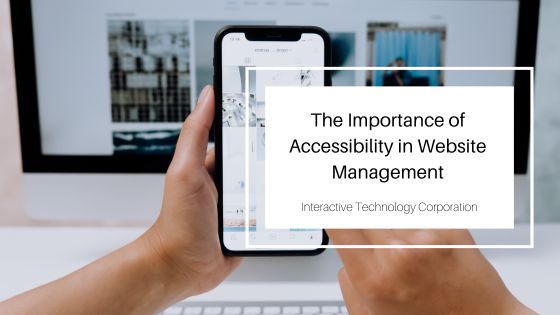Accessibility in website management is not just a matter of compliance; it’s a crucial element that determines whether a website is usable by everyone, regardless of their abilities. Ensuring that your website is accessible is essential for reaching a broader audience, improving user experience, and enhancing your brand’s reputation. In this blog, we will explore the importance of accessibility in website management and how it can benefit both users and businesses.
1. Expanding Your Audience
The internet is a global resource, and your website should be accessible to many people. According to the World Health Organization (WHO), over a billion people worldwide live with some form of disability. This includes visual, auditory, physical, speech, cognitive, and neurological disabilities. By making your website accessible, you open your doors to a significant portion of the population that might otherwise be excluded.
For example, ensuring that your website is navigable by keyboard helps users with mobility impairments, while providing text alternatives for images and videos benefits those who are visually impaired. Captions and transcripts for audio content make your website more accessible to users with hearing impairments. When your website is designed with these considerations in mind, it can serve a wider audience and foster inclusivity.
2. Legal Compliance and Avoiding Penalties
Accessibility is not just a best practice; it’s a legal requirement in many regions. Laws such as the Americans with Disabilities Act (ADA) in the United States and the Web Content Accessibility Guidelines (WCAG) set by the World Wide Web Consortium (W3C) establish standards that websites must meet to be considered accessible. Failing to comply with these standards can result in legal action, fines, and damage to your brand’s reputation.
Many businesses have faced lawsuits for not having accessible websites, leading to costly settlements and a loss of consumer trust. By proactively ensuring that your website meets accessibility standards, you protect your business from legal risks and demonstrate a commitment to inclusivity.
3. Improved User Experience
Accessibility and user experience (UX) are closely linked. An accessible website is often a more user-friendly website. Features like straightforward navigation, easy-to-read text, and fast loading times benefit all users, not just those with disabilities. For example, a well-structured website with logical headings and labels makes it easier for users to quickly find the information they need.
Furthermore, accessible websites tend to be more compatible with assist
ive technologies like screen readers allow visually impaired users to navigate and interact with the web. When a website is designed with accessibility, it enhances the overall user experience, leading to increased engagement, lower bounce rates, and higher conversion rates. Ultimately, by prioritizing accessibility, you create a more intuitive and enjoyable website for everyone.
4. Boosting SEO and Visibility
Accessibility improvements can also positively impact your website’s search engine optimization (SEO). Many accessibility practices align with SEO best practices, such as using descriptive alt text for images, providing transcripts for video and audio content, and ensuring a logical heading structure. These elements help search engines understand and index your content more effectively, improving your website’s visibility in search results.
Moreover, accessible websites are more likely to be shared and recommended by users, leading to increased traffic and a broader online presence. By focusing on accessibility, you can enhance your website’s SEO performance, making it easier for all users to find and engage with your content.
5. Building Brand Reputation and Loyalty
An accessible website reflects positively on your brand, demonstrating that you value inclusivity and are committed to serving all customers, regardless of their abilities. This commitment can foster trust and loyalty among users, who are more likely to support businesses prioritising accessibility.
Consumers increasingly choose brands that align with their values in today’s socially conscious market. By making your website accessible, you comply with legal standards and position your brand as socially responsible. This can lead to stronger customer relationships and a more positive brand image.
Conclusion
Accessibility in website management is essential for creating an inclusive online environment that serves all users, regardless of their abilities. By prioritizing accessibility, you can expand your audience, improve user experience, enhance your SEO, and build a positive brand reputation. As the digital landscape evolves, ensuring that your website is accessible is not just a matter of compliance—it’s a strategic business decision that can lead to long-term success and growth.

